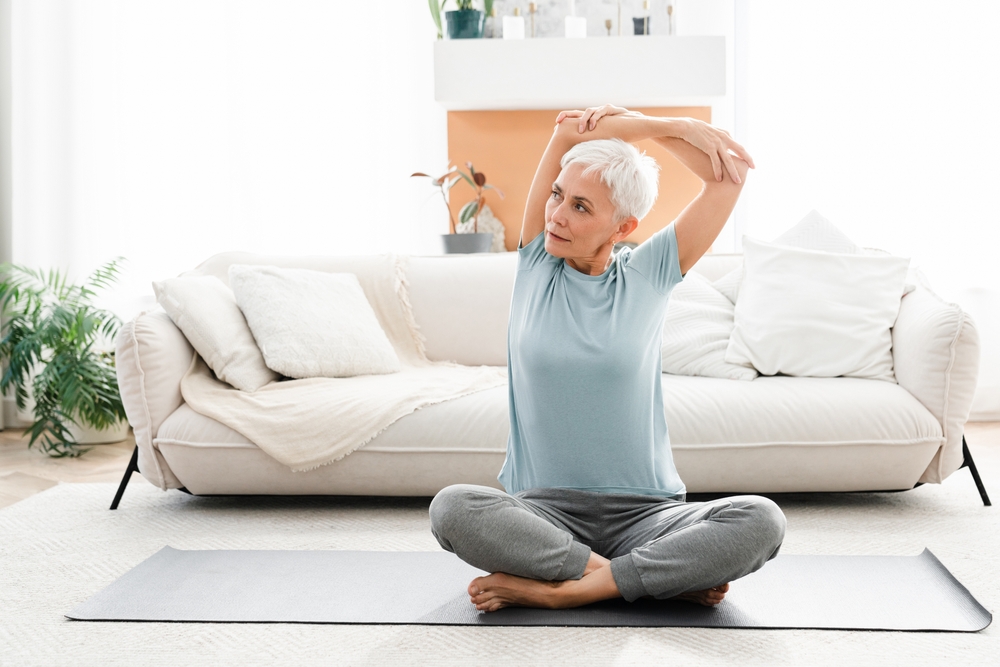Movement Through Menopause: The Six Most Supportive Exercises for This Transition

In most situations you’ll find me advocating that more movement is better than less and during the perimenopause or menopause that is still indeed true. However, during this transitional time the mantra shifts slightly to: more mindful movement is better. This is a time when listening to your body becomes not just helpful, but a must. Hormonal fluctuations can affect energy levels, exercise recovery, sleep, appetite, mood and even motivation. So, while staying active is one of the most powerful tools we have, it’s equally important to listen in to what your body is telling you.
The conversation around menopause has grown a lot in recent years. It’s long overdue if you ask me, given that it directly affects half the population at one point and the other half indirectly. Events like National Menopause Day, held annually on 18 October, have helped bring this life stage into the spotlight, encouraging open dialogue, breaking down stigma, and advocating for better support systems. Campaigns like Educate Yourself link (Educate Yourself about Menopause) have amplified diverse voices and experiences, reminding us that menopause is not a one-size-fits-all journey. This cultural shift is empowering more women to seek information, share stories and embrace movement as a form of self-care.
Understanding the Transition: Common Symptoms of Perimenopause and Menopause
Perimenopause and menopause are marked by a wide range of symptoms, driven largely by changing levels of oestrogen and progesterone. These may include:
- Hot flushes and night sweats
- Sleep disturbances
- Mood changes, including anxiety or low mood
- Weight gain, particularly around the abdomen
- Reduced bone density and muscle mass
- Joint stiffness and decreased mobility
- Fatigue and brain fog
These symptoms can vary widely in intensity and duration, but movement, especially the right kind, can help mitigate many of them.
The Six Most Supportive Exercises for Perimenopause and Menopause
Each of these exercises have been chosen not just for its physical benefits, but for its emotional and social impact too. Together, they form a well-rounded approach to movement that supports strength, stability, mood and connection.
1. Walking
Why it matters: Walking is low-impact, accessible, and incredibly effective for cardiovascular health, bone density and mood regulation.
How to use it: Aim for 20–30 minutes most days. Vary your pace, explore nature trails, or use it as a mindful break between tasks. Even short walks can help reduce hot flashes and improve sleep quality.
2. Pilates or Yoga
Why it matters: These practices support flexibility, core strength, and balance while calming the nervous system and reducing stress.
How to use it: Choose gentle flows or mat-based Pilates routines that focus on breath and alignment. These can ease joint stiffness, support pelvic health and improve body awareness.
3. Core-Focused Movements
Why it matters: Lifestyle including sedentary jobs, a busy or unbalanced work life and modern life in general can affect posture and pelvic stability negatively. Core exercises help protect the spine and support functional movement.
How to use it: Dead bugs, bird-dogs and glute bridges are excellent choices. Focus on slow, controlled movements and deep abdominal engagement. These exercises also support bladder control and reduce lower back pain.
4. Posture-Based Strength (Rows for Upper Back)
Why it matters: Oestrogen decline can lead to muscle loss and postural changes. Strengthening the upper back helps counteract rounded shoulders and neck tension.
How to use it: Use resistance bands or light weights to perform rows, reverse flys, or other shoulder blade retraction movements like dumbwaiters. These exercises improve upper back strength, they also help to stretch out our chest muscles and therefore improve overall posture, reduce discomfort and support confidence in daily movement.
5. Wall Sits
Why it matters: Wall sits build lower body strength and endurance without high impact—supporting joint stability and bone health.
How to use it: Slide down a wall until your knees are at 90 degrees. Hold for 30–60 seconds, rest and repeat. They’re great for multitasking, try them while brushing your teeth or waiting for the kettle to boil.
6. Social Movement (Tennis, badminton, jogging or rambling group activities)
Why it matters: Connection can be a type of therapy that works for most people. Social exercise boosts mood, motivation and mental health, especially during a time when isolation can creep in.
How to use it: Join a local tennis group, walking club, or dance class. The goal isn’t necessarily competition, it’s joy, laughter, and shared movement. Bonus: outdoor activities also support vitamin D levels and sleep regulation.
It is so important to remind ourselves that menopause isn’t a decline but a recalibration. Movement can be a powerful tool to tap in to, not just for physical health but for emotional resilience and self-care. The key is consistency, compassion and choosing exercises that feel good in your body.
If consistency or accountability is the thing that is holding you back then I can help! Reach out to find out how working with a personal trainer can increase your chances at successful making lifestyle changes.
